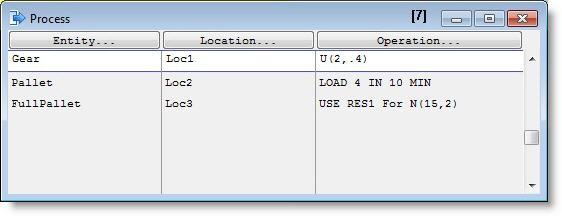
You are here: Building the Model: Advanced Elements > Modeling Tips > Batching & Unbatching Entities > LOAD/UNLOAD Statements
Another method of batching and unbatching involves the LOAD and UNLOAD statements. As with the GROUP statement, ProModel maintains the identities and attributes of the batched entities. Therefore, when you use the UNLOAD statement, each entity still has its attribute assignments.
The difference between LOAD and GROUP is that LOAD requires a "base" entity on which you temporarily load other entities that might represent a pallet or container. Also, the entities you are going to load, travel to the loading location on an "If load request" routing rule.
In the following example, four Gears are loaded onto a pallet. Pallet is the entity which issues the LOAD statement. In addition, the example includes a time element (LOAD 4 in 10 min). This means "load 4 gears or wait 10 minutes, whichever occurs first." If after 10 minutes only 3 gears arrive, the entity loaded with the 3 gears continues.


Note that the loaded entity, Gear, has "LOAD" in the Routing Rule field as shown here. This tells ProModel that the gear only goes to Loc2 when a Load command requests it.


Since the example does not specify an entity type as part of the LOAD statement, ProModel will load temporarily any entity type waiting for the LOAD request. To control which entity types the model loads, use the "IFF" option with the LOAD statement (e.g., LOAD 4 IFF Entity()=gear).
Once the batch moves to its destination, the model uses the UNLOAD statement to break it into individual components (Gear and Pallet). You must define a routing for the entity Gear after the UNLOAD takes place. Typical uses for LOAD/UNLOAD are palletizing operations, AGV systems, and AS/RS systems.